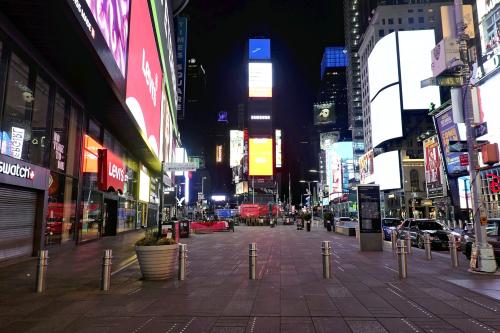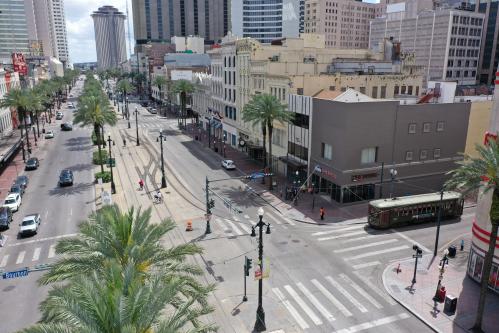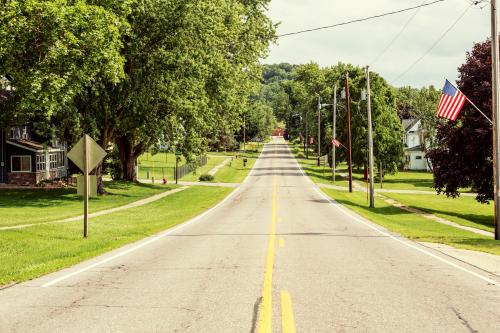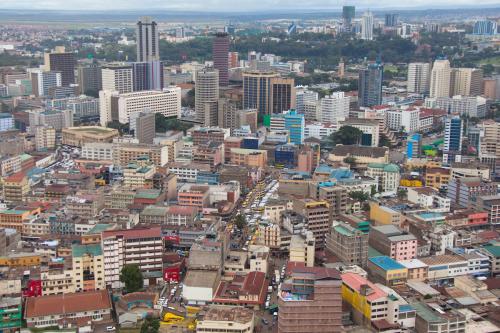The following is an excerpt from Reopening the World: How to Save Lives and Livelihoods, a new report where Brookings experts offer ideas to help policymakers protect lives and save livelihoods in the midst of the current COVID-19 pandemic.
 U.S. cities have been at the forefront of the national response to COVID-19, as global connections and high density make them especially vulnerable. Local decision-makers banded together early on and also looked to their global networks to exchange knowledge, share experiences, and support each other in managing through the crisis. For example, Mayor Eric Garcetti of Los Angeles, chair of C40 cities, convened a virtual assembly in late March of 45 mayors from every part of the world, and the consensus was clear from counterparts whose cities had already been affected: act aggressively and quickly.
U.S. cities have been at the forefront of the national response to COVID-19, as global connections and high density make them especially vulnerable. Local decision-makers banded together early on and also looked to their global networks to exchange knowledge, share experiences, and support each other in managing through the crisis. For example, Mayor Eric Garcetti of Los Angeles, chair of C40 cities, convened a virtual assembly in late March of 45 mayors from every part of the world, and the consensus was clear from counterparts whose cities had already been affected: act aggressively and quickly.
The cooperation has been paying off. U.S. mayors and local officials are receiving high marks for their response. In a recent Economist/YouGov poll, a majority (55 percent) said their local governments are doing a good or excellent job, while about two in five (38 percent) placed the same faith in the federal government. The most recent Edelman Trust Barometer shows local governments in the U.S. enjoying a level of trust 20 percentage points higher than the federal government.
On the one hand, reopening represents a complicated technical challenge. As Brookings and other experts have suggested, it requires getting a sequence of steps right, based on the best available evidence, and balancing public health with economic and social considerations amid uncertainty. At a deeper level, though, reopening presents a serious leadership challenge. Municipal leaders are likely to allow activity among certain groups of people, businesses, and neighborhoods before others, which may be perceived as unfair. Subsequent flare-ups of the disease may mean restrictions are quickly reintroduced.
Amid the urgency to restart the economy and restore jobs, these dynamics create high risk of increased anxiety, tensions, and social division. At the same time, mayors are more convinced than ever of the need to reduce vulnerabilities exposed by COVID-19. And they are faced with doing this as they are experiencing severe budget shortfalls. These local leaders recognize that the effects of the virus on their cities’ physical and economic makeup may be long-lasting. COVID-19 is yet another example of the extent to which their local realities are tied to global phenomena that ignore political boundaries: global health threats, climate change, migration. Their counterparts from across the globe have additional lessons to share.
For these mayors, social equity matters now more than ever, and they have elevated their city’s commitment to reaching their city’s most vulnerable and maximizing economic opportunity for all their residents.
COMMIT TO ‘BUILDING BACK BETTER’
As they emerge from lockdown, local leaders worldwide see reopening as an opportunity. The mayors of Milan, Helsinki, Bristol, and several other global cities whom we contacted are determined to reduce their cities’ vulnerabilities, and not just as they relate to COVID-19: they see a chance to build a healthier, more sustainable future that improves their cities’ resilience to a wide range of shocks and shifts. This means addressing the economic inequities and environmental stresses that make their cities susceptible—and doing so now.
As the city reopens, the government of Milan made a commitment to raise its ambition for the future of the city. It is starting to rethink community patterns and plans to construct expanded pedestrian and bicycle access on 22 miles of streets in the city this summer, reducing availability for cars. These throughways will follow subway routes to provide greater mobility for those reliant on public transportation and incentives for those who are not. Milan anticipates this will not only help lessen car usage and air pollution—its metro region has one of the highest in Europe—but create more space for commerce outside its restaurants and shops, which may be important in the era of social distancing.
Successfully anticipating global trends and integrating these transformations into reopening and recovery was a recurrent theme among these city leaders. None has set aside their city’s prior plans to address climate change, build cleaner infrastructure, and reduce inequality among their residents and neighborhoods. Helsinki, for example, has continued with its Helsinki Energy Challenge, a global competition to reduce its dependence on coal, which now heats half the city. Bristol remains committed to its One City Climate Strategy, launched in February, and is framing its model of economic recovery on the Sustainable Development Goals. COVID-19 may be a disruption, but it is not a moratorium; if anything, it has provided greater urgency for these leaders to accelerate their plans.
MAKE EQUITY THE CENTERPIECE OF YOUR CITY’S PLANS
COVID-19’s widespread economic dislocation lays bare the implications of inequality. For these mayors, social equity matters now more than ever, and they have elevated their city’s commitment to reaching their city’s most vulnerable and maximizing economic opportunity for all their residents.
The mayor of Milan launched a Mutual Aid Fund for private donations to augment a special appropriation from the City Council, both to provide grants to the newly unemployed and, as the city reopens, to offer assistance to small businesses and entrepreneurs. To develop an equitable approach to enhance safety, the city is considering the possibilities of augmenting “social distancing” with “time distancing,” staggering openings and closings or the start of shifts to space out the use of public transportation.
Bristol’s mayor has also committed to an inclusive re-opening, and the city is providing emergency grants to small businesses. Its Economic Board is focused on reducing intractable inequality in the city by creating suitable job opportunities out of its recovery plans and implementation of the climate strategy.
This emphasis is becoming a widely shared view. Social equity and local economies were the top priorities for COVID-19 recovery planning in a recent survey of the cities participating in the Rockefeller Foundation’s Global Resilient Cities Network, which launched a coalition of Cities for a Resilient Recovery based on the results.
USE CITY GOVERNANCE AS A PLATFORM FOR PROBLEM-SOLVING
It may seem counterintuitive to remain steadfast about a city’s ambitions as uncertainty and disruption continue to define its daily realities. These leaders recognize that success will require resources and leadership that extend beyond their budgets and capacity, and pursue a model of governance that is as much community organizer and advocate as producer of public services. As one senior representative from Helsinki remarked, the mayor’s office is well-positioned to help the city build its collective leadership, acting as the connective tissue among many different sectors seeking to solve their problems.
Bristol’s Economy Board, for example, is one of six boards created before the crisis to involve a diverse range of stakeholders in developing and leading the implementation of its One City Plan. Activated immediately to develop a post-COVID-19 economic recovery plan, its membership has swelled to over 40 representatives from businesses, unions, universities, civil society, and gateways such as its port and airport. Its overlap with the city’s other boards and participatory nature is positioning the city to develop a strategy and shovel-ready projects that will have community-wide support and meet the city’s post-COVID-19 priorities.
COMMUNICATE OPENLY AND TRANSPARENTLY
Such consultation is an example of the type of regular and transparent communication these leaders see as essential to building support from constituents and the general public. Seoul, applying lessons from the MERS outbreak of 2015, has made transparency a core principle of its reopening strategy, offering real-time data on the number and location of cases to mitigate public fear, reduce the spread of fake news, and increase trust in government officials. Buenos Aires retooled its existing municipal WhatsApp chatbot for coronavirus communications and has achieved a response rate five times quicker than its traditional telephone emergency response.
UNIFY THE CITY AROUND ITS CULTURAL IDENTITY
It is one of the iconic images of the COVID-19 crisis, seen by 22 million people as it streamed: Andrea Bocelli, standing in the empty Piazza del Duomo in Milan on Easter Sunday, singing “Amazing Grace.” As Milan embraces its own commitment to open communication with its residents, it is unveiling a campaign that echoes that image to show how the piazza and the city will reopen “step by step.” In similar fashion, Bristol is using its #WeAreBristol campaign, launched in 2019 to define its diverse culture as one of the city’s hallmarks, to sign up volunteers for COVID-19 relief.
Such reminders of their city’s shared identity are useful as a way to build a sense of solidarity and togetherness. The crisis has had a deep economic impact on the cultural and creative sectors, and intentionally acknowledging the central role cultural institutions play in the life of their city signals the commitment by the communities to work toward their renewal. As U.S. leaders embark upon reopening and the first steps toward recovery, such goodwill will be important to sustaining their efforts—and remaking their cities for the future.
Max Bouchet contributed excellent research assistance to collect these lessons.






Commentary
Reopening the World: City leadership is fundamental to reopening the economy
July 2, 2020